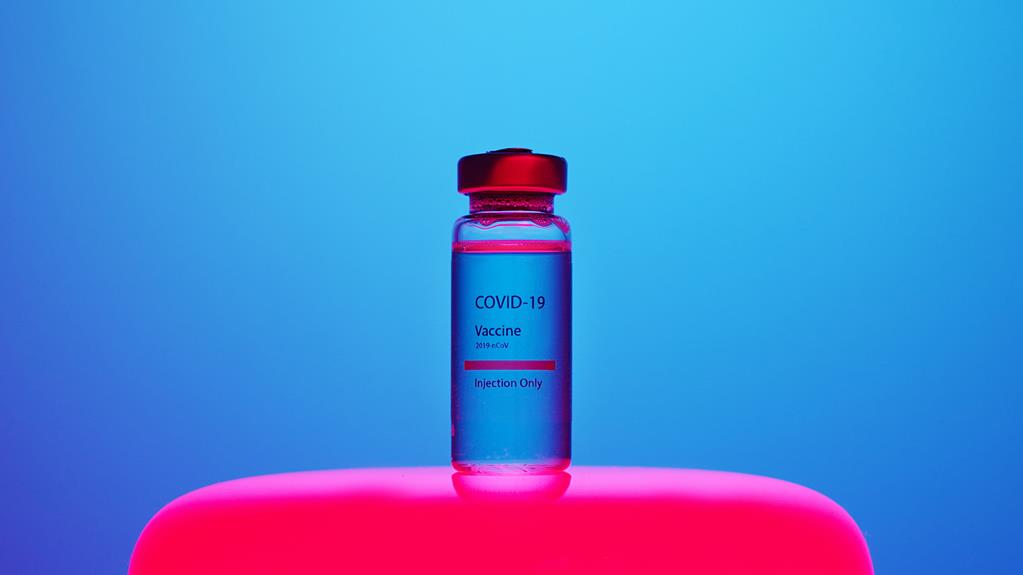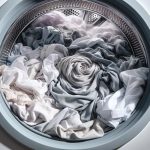Tired of pulling your whites out of the wash only to find a hint of pink? It's frustrating when your efforts to keep your whites bright are thwarted. But fear not, there are practical steps you can take to prevent this color mishap and maintain the pristine look of your whites.
By following a few simple laundry guidelines, you can ensure that your whites stay white. From sorting your laundry properly to choosing the right detergent, these strategies will help you achieve mastery over keeping your whites from turning pink.
With attention to detail and the right approach, you can conquer this common laundry challenge and keep your whites looking crisp and clean.
Key Takeaways
- Separate laundry by color and fabric type to prevent color bleeding
- Use color-catcher sheets in each mixed load to trap loose dyes and prevent color transfer
- Pre-treat stains before washing white garments to maintain their pristine whiteness
- Choose a suitable detergent formulated for whites and consider fabric type when selecting one
Sort Laundry Properly
To prevent your whites from turning pink, sort laundry by color and fabric type before washing. Proper laundry organization is essential for fabric care and color preservation. Start by separating your whites from colored items to avoid color bleeding.
Additionally, sort your laundry based on fabric type, separating delicate items from more durable ones. This not only prevents color transfer but also ensures that each fabric receives the appropriate washing and drying treatment it requires.
By sorting your laundry properly, you can also address stain removal more effectively. Sorting allows you to treat stains based on their type and color, increasing the chances of successful stain removal. For example, treating a coffee stain on a white shirt requires different methods than treating a similar stain on a colored garment.
Organizing your laundry before washing also helps to prevent white items from picking up dye from other clothes, ultimately safeguarding them from turning pink or any other unwanted shade.
Use Color-Catcher Sheets
When doing laundry, color-catcher sheets can be a game changer. These handy sheets work by trapping loose dyes in the wash, preventing them from transferring onto your whites.
It's a simple and effective solution for keeping your whites looking bright and clean.
Color-Catcher Sheets Trap Dyes
You can prevent your whites from turning pink by using color-catcher sheets to trap dyes when washing mixed loads.
Color-catcher sheets are highly effective at trapping dyes, thus ensuring the protection of your laundry colors.
These sheets work by absorbing and trapping loose dyes in the water, preventing them from transferring onto your white fabrics.
By incorporating color-catcher sheets into your laundry routine, you can confidently wash mixed loads without worrying about color bleeding or dye transfer.
This simple yet powerful solution provides an extra layer of protection for your whites and other light-colored garments, allowing you to maintain their pristine appearance.
Make sure to always include a color-catcher sheet in each mixed load to maximize the effectiveness of dye trapping and safeguard the vibrancy of your whites.
Prevents Color Transfer
How can color-catcher sheets effectively prevent color transfer when washing mixed loads? By incorporating them into your laundry routine, you can confidently protect your whites and other light-colored garments from dye transfer.
These sheets work by trapping loose dyes in the water, preventing them from being absorbed by other fabrics. To use them, simply place a color-catcher sheet in the washing machine along with your mixed load. The sheet will absorb any loose dyes, preventing them from redepositing onto your white or light-colored clothing.
This simple step can help maintain the vibrancy and brightness of your garments, providing an extra level of fabric care. Incorporating color-catcher sheets into your laundry routine is a valuable laundry tip to prevent color transfer and ensure the longevity of your clothing.
Easy Laundry Solution
Consider incorporating color-catcher sheets into your laundry routine to effectively prevent color transfer and maintain the brightness of your whites and light-colored garments. These sheets work by trapping loose dyes in the water, preventing them from redepositing onto your clothes. They are a simple and efficient solution to keep your laundry organized and prevent dye absorption mishaps. Here's a table to illustrate the effectiveness of color-catcher sheets:
| Situation | Without Color-Catcher Sheets | With Color-Catcher Sheets |
|---|---|---|
| Mixed Color Load | Pinkish tint on whites | Whites stay bright |
| New Garment Wash | Dye transfer occurs | Dyes are absorbed |
| Hard Water Usage | Dullness in light colors | Colors remain vibrant |
Incorporating color-catcher sheets into your laundry routine can make a noticeable difference in maintaining the vibrancy of your whites and light-colored garments.
Wash Whites Separately
When washing whites, it's important to separate them from colored items to prevent color bleeding. This can help maintain the brightness and whiteness of your garments.
Additionally, delicate fabrics should be washed separately to avoid damage.
Color Bleeding Prevention
To prevent color bleeding, always separate your whites from colored clothing when doing laundry. This is a crucial fabric care practice that minimizes the risk of dyes from colored garments bleeding onto your white clothes. Implementing this simple step can help maintain the crispness and brightness of your whites.
When washing whites separately, you can also utilize laundry tips such as using cold water and a gentle detergent specifically designed for white fabrics. Additionally, consider using color-catching laundry sheets or detergents to further prevent color bleeding.
Separating Delicate Fabrics
To effectively protect your white clothing from color bleeding, always wash delicate fabrics separately, especially when dealing with whites, to minimize the risk of discoloration. When separating delicate fabrics, utilize the gentle cycle to ensure the fabric care is maintained while effectively cleaning your whites.
This extra precaution is crucial for preventing color transfer from other garments, ultimately preserving the brightness of your white clothing. By adhering to this color protection method, you can maintain the pristine appearance of your whites.
Additionally, following this laundry tip will help you avoid the frustration of discovering pink tinges on your white clothing. Taking the time to separate delicate fabrics and wash whites separately demonstrates your commitment to maintaining the quality and appearance of your clothing.
Pre-Treat Stains
To effectively prevent your whites from turning pink, begin by pre-treating any stains before washing your garments. Stain removal is a crucial step in fabric care, and it's particularly important when dealing with white clothing. Before tossing your white garments into the washing machine, take the time to pre-treat any visible stains. This simple yet essential step can make a significant difference in maintaining the pristine whiteness of your clothes.
When pre-treating stains, it's important to use the right products and techniques. For organic stains like food or sweat, applying a small amount of liquid detergent directly to the stained area can help break down the particles before washing. For tougher stains such as wine or coffee, consider using a specialized stain remover or a mixture of water and white vinegar. Gently rub the pre-treatment solution into the stain, being careful not to spread it further.
Allow the pre-treatment to sit for at least 10-15 minutes before proceeding with the regular wash cycle. This extra step in your laundry routine can go a long way in preserving the brightness of your white clothing.
Avoid Overcrowding the Washer
Preventing your whites from turning pink requires avoiding overcrowding the washer. Proper washer maintenance and laundry organization play a crucial role in achieving pristine white clothes. Here's why overcrowding the washer can lead to pink stains on your whites:
- Even Distribution: Overcrowding prevents the water and detergent from circulating evenly, leading to inadequate cleaning and potential dye transfer.
- Proper Agitation: A crowded washer may hinder the agitator's movement, reducing its ability to effectively remove stains and dirt from your clothes.
- Detergent Dispersion: In an overcrowded load, the detergent may not disperse evenly, leaving some areas of your laundry undercleaned and prone to discoloration.
- Air Circulation: Overcrowding restricts air circulation, which is essential for thorough cleaning and preventing dye bleeding.
- Wear and Tear: Excessive crowding can strain the washer's components and decrease its efficiency over time, leading to subpar cleaning results.
To avoid these issues, organize your laundry loads carefully, ensuring there's enough room for the clothes to move freely. Consider following the manufacturer's guidelines for load capacity and prioritize maintaining a balance between a full load and ample space for effective cleaning.
Choose a Suitable Detergent
Select a detergent specifically formulated for whites to maintain their brightness and prevent color transfer. Consider the fabric type when choosing a detergent.
For natural fibers like cotton and linen, opt for a gentle, bleach-free detergent to prevent yellowing or weakening of the fibers.
For synthetic fabrics such as polyester or nylon, a detergent designed to remove stains and brighten whites without damaging the fabric is ideal.
Read the detergent ingredients carefully, as optical brighteners can help maintain the whiteness of your clothes. These ingredients work by absorbing UV light and re-emitting it as blue light, which can counteract the yellowing that occurs over time.
Moreover, for washing machines, both top-loading and front-loading machines can affect detergent effectiveness. High-efficiency (HE) washing machines require detergents with low sudsing properties to prevent residue buildup, while traditional top-loading machines can accommodate a wider range of detergents.
Check Water Temperature
First, set your washing machine to the hottest water temperature recommended for the fabric of your whites to effectively remove stains and prevent color transfer.
- Check Water Quality: Ensure that your water quality is suitable for washing whites. Hard water can leave mineral deposits on your clothes, affecting their brightness.
- Use Vinegar Rinse: Add a vinegar rinse during the rinse cycle to remove any residual detergent and mineral buildup. This helps to keep your whites looking crisp and bright.
- Avoid Overheating: While hot water is effective for removing stains, be cautious not to use excessively high temperatures as this can cause shrinkage or damage to delicate fabrics.
- Consider Cold Pre-Soak: For heavily soiled whites, consider doing a cold pre-soak before washing to lift stains without setting them further into the fabric.
- Follow Fabric Care Labels: Always check the care labels on your whites to ensure that you're using the appropriate water temperature for the specific fabric.
Maintain Washer Cleanliness
To maintain washer cleanliness, regularly clean the detergent dispenser and rubber gasket to prevent mold and mildew buildup. It's essential to keep your washing machine in top condition to avoid any unwanted color transfer or dye bleeding onto your whites. Here's a simple maintenance guide to ensure your washer stays clean and functions effectively:
| Task | Frequency | How to Perform |
|---|---|---|
| Clean detergent dispenser | Every 1-2 weeks | Remove the dispenser and soak it in warm, soapy water. Rinse |
| Clean rubber gasket | Every month | Wipe the gasket with a solution of equal parts water and vinegar to remove mold and mildew |
| Run a cleaning cycle with affresh® | Every 2 months | Use affresh® Washer Cleaner to eliminate odor-causing residues |
Regular cleaning helps prevent the accumulation of dirt, detergent, and fabric softener residues, which can lead to unpleasant odors and mold growth. Additionally, modern washers are equipped with dye trapping technology to minimize color bleeding. By maintaining your washer's cleanliness and utilizing its features, you can effectively prevent your whites from turning pink.
Frequently Asked Questions
Can I Use Bleach to Prevent My Whites From Turning Pink?
Yes, you can use bleach to prevent your whites from turning pink. However, consider using color catcher sheets or a vinegar alternative in the wash to prevent color bleeding without damaging your whites.
What Should I Do if My White Clothes Still Turn Pink After Following These Tips?
If your white clothes still turn pink, try using color-removing products or alternatives. Consider fabric care techniques, like pre-soaking in vinegar or baking soda. Check the garment tag for specific instructions, and avoid mixing whites with colored items.
Are There Any Specific Types of Detergents That Work Better for Preventing Pink Stains on Whites?
For preventing pink stains on whites, the best detergents are those labeled as color-safe and specifically designed for brightening whites. Avoid fabric softeners and opt for color-safe bleach. Also, use effective stain removal techniques.
How Often Should I Clean My Washer to Prevent Pink Stains on My Whites?
To prevent pink stains on your whites, clean your washer regularly. Consider cleaning it every 1-3 months to prevent mold and mildew buildup, which can cause pink stains. Regular maintenance helps keep your whites looking fresh.
Can I Use Vinegar as a Natural Alternative to Color-Catcher Sheets?
You can use vinegar as a natural alternative to color-catcher sheets. Trying baking soda or lemon juice may also help prevent whites from turning pink. Add a cup of vinegar to the wash cycle for best results.
- How Does Ring Spun Cotton Affect Garment Fit and Shape Retention? - August 13, 2024
- What Are the Challenges in Producing Ring Spun Cotton? - August 13, 2024
- Is Ring Spun Cotton Suitable for Plus-Size Clothing? - August 13, 2024






